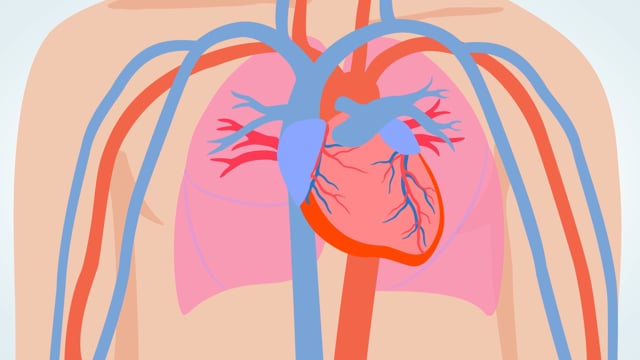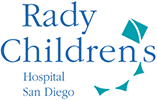Heart and Circulatory System
What Does the Heart Do?
The heart is a pump, usually beating about 60 to 100 times per minute. With each heartbeat, the heart sends blood throughout our bodies, carrying oxygen to every cell. After delivering the oxygen, the blood returns to the heart. The heart then sends the blood to the lungs to pick up more oxygen. This cycle repeats over and over again.
What Does the Circulatory System Do?
The circulatory system is made up of blood vessels that carry blood away from and towards the heart. Arteries carry blood away from the heart and veins carry blood back to the heart.
The circulatory system carries oxygen, nutrients, and hormones to cells, and removes waste products, like carbon dioxide. These roadways travel in one direction only, to keep things going where they should.

Watch the Heart Pump
Animation showing the normal heart anatomy and blood pumping through pulmonary and systemic circulation.
What Are the Parts of the Heart?
The heart has four chambers — two on top and two on bottom:
- The two bottom chambers are the right ventricle and the left ventricle. These pump blood out of the heart. A wall called the interventricular septum is between the two ventricles.
- The two top chambers are the right atrium and the left atrium. They receive the blood entering the heart. A wall called the interatrial septum is between the atria.
The atria are separated from the ventricles by the atrioventricular valves:
- The tricuspid valve separates the right atrium from the right ventricle.
- The mitral valve separates the left atrium from the left ventricle.
Two valves also separate the ventricles from the large blood vessels that carry blood leaving the heart:
- The pulmonic valve is between the right ventricle and the pulmonary artery, which carries blood to the lungs.
- The aortic valve is between the left ventricle and the aorta, which carries blood to the body.
What Are the Parts of the Circulatory System?
Two pathways come from the heart:
- The pulmonary circulation is a short loop from the heart to the lungs and back again.
- The systemic circulation carries blood from the heart to all the other parts of the body and back again.
In pulmonary circulation:
- The pulmonary artery is a big artery that comes from the heart. It splits into two main branches, and brings blood from the heart to the lungs. At the lungs, the blood picks up oxygen and drops off carbon dioxide. The blood then returns to the heart through the pulmonary veins.
In systemic circulation:
- Next, blood that returns to the heart has picked up lots of oxygen from the lungs. So it can now go out to the body. The aorta is a big artery that leaves the heart carrying this oxygenated blood. Branches off of the aorta send blood to the muscles of the heart itself, as well as all other parts of the body. Like a tree, the branches gets smaller and smaller as they get farther from the aorta.
At each body part, a network of tiny blood vessels called capillaries connects the very small artery branches to very small veins. The capillaries have very thin walls, and through them, nutrients and oxygen are delivered to the cells. Waste products are brought into the capillaries.
Capillaries then lead into small veins. Small veins lead to larger and larger veins as the blood approaches the heart. Valves in the veins keep blood flowing in the correct direction. Two large veins that lead into the heart are the superior vena cava and inferior vena cava. (The terms superior and inferior don't mean that one vein is better than the other, but that they're located above and below the heart.)
Once the blood is back in the heart, it needs to re-enter the pulmonary circulation and go back to the lungs to drop off the carbon dioxide and pick up more oxygen.
How Does the Heart Beat?
The heart gets messages from the body that tell it when to pump more or less blood depending on a person's needs. For example, when we're sleeping, it pumps just enough to provide for the lower amounts of oxygen needed by our bodies at rest. But when we're exercising, the heart pumps faster so that our muscles get more oxygen and can work harder.
How the heart beats is controlled by a system of electrical signals in the heart. The sinus (or sinoatrial) node is a small area of tissue in the wall of the right atrium. It sends out an electrical signal to start the contracting (pumping) of the heart muscle. This node is called the pacemaker of the heart because it sets the rate of the heartbeat and causes the rest of the heart to contract in its rhythm.
These electrical impulses make the atria contract first. Then the impulses travel down to the atrioventricular (or AV) node, which acts as a kind of relay station. From here, the electrical signal travels through the right and left ventricles, making them contract.
One complete heartbeat is made up of two phases:
- The first phase is called systole (SISS-tuh-lee). This is when the ventricles contract and pump blood into the aorta and pulmonary artery. During systole, the atrioventricular valves close, creating the first sound (the lub) of a heartbeat. When the atrioventricular valves close, it keeps the blood from going back up into the atria. During this time, the aortic and pulmonary valves are open to allow blood into the aorta and pulmonary artery. When the ventricles finish contracting, the aortic and pulmonary valves close to prevent blood from flowing back into the ventricles. These valves closing is what creates the second sound (the dub) of a heartbeat.
- The second phase is called diastole (die-AS-tuh-lee). This is when the atrioventricular valves open and the ventricles relax. This allows the ventricles to fill with blood from the atria, and get ready for the next heartbeat.
How Can I Help Keep My Child's Heart Healthy?
To help keep your child's heart healthy:
- Encourage plenty of exercise.
- Offer a nutritious diet.
- Help your child reach and keep a healthy weight.
- Go for regular medical checkups.
- Tell the doctor about any family history of heart problems.
Let the doctor know if your child has any chest pain, trouble breathing, or dizzy or fainting spells; or if your child feels like the heart sometimes goes really fast or skips a beat.
- About Body Basics
- Heart Health (Topic Center)
- Heart Murmurs
- Patent Ductus Arteriosus (PDA)
- Patent Foramen Ovale (PFO)
- Cardiomyopathy
- Interrupted Aortic Arch (IAA)
- Cardiac Catheterization
- Congenital Heart Defects
- Atrial Septal Defect (ASD)
- Mitral Valve Prolapse
- Arrhythmia (Abnormal Heartbeat)
- Supraventricular Tachycardia (SVT)
- Body Basics: The Heart (Slideshow)
- Words to Know (Heart Glossary)

© 1995- The Nemours Foundation. KidsHealth® is a registered trademark of The Nemours Foundation. All rights reserved.
Images sourced by The Nemours Foundation and Getty Images.
